

By Lora Koenig
McMurdo (Antarctica), 6 December — We have been getting a lot of questions about the wildlife that we have seen in Antarctica. Here are some pictures that Ludo snapped of the Weddell seals we saw in McMurdo. We have seen lots of seals lounging on the sea ice, and also skuas, which look like large seagulls. We have not seen any penguins yet.


By Lora Koenig
On December 5, we boomeranged to and from the airport. Here is a picture of Ludo and Clem in the inside of Ivan the Terra Bus on our way from McMurdo to the airport, Pegasus Field, for our flight to Byrd.
 And here is a picture of Ludo and Clem in the back of a Delta on our way back from the airport to McMurdo.
And here is a picture of Ludo and Clem in the back of a Delta on our way back from the airport to McMurdo.
In the pictures they seem just as happy returning from the airport as they were going, but I think that was just for the camera.
We were all very excited about our flight to Byrd because we were already a week delayed in getting into the deep field. (Camps in the middle of Antarctica, outside of McMurdo Station, are called “the deep field.”) We boarded Ivan just after lunch for the 1 hour and 10 minute ride to Pegasus Field. Once at Pegasus, we were at the passenger terminal of the airport, a triple-wide trailer house that sits on a sled so it can be moved (it also serves as the Galley for airport workers), when we were told that the flight was canceled due to weather at Byrd. We were all a little sad because we want to get to Byrd to start collecting our science data. Our flight was canceled for good reason though; there was less than 100-meter visibility with high winds and blowing snow at Byrd, so there was no way a plane could land! We headed back into McMurdo and made it in time for dinner.
McMurdo is a small town and slightly more than 1,100 people are in there now, so all of our friends noticed that we were back. Everyone keeps asking when we are going to get to the field. Well, we are going to try again today, December 7. We are scheduled for another flight with transport to the airport at 1645 this afternoon. Take off is scheduled for 7 PM and we’ll land at Byrd at around 10:30 PM if all goes well.
Actually, I think we were all secretly happy to have another Wednesday lunch in McMurdo because on Wednesdays we get cookies. We will all take a few extra cookies in our backpacks for a midnight snack at Byrd, if we make it tonight.
I am particularly anxious to get to Byrd soon because, this year, I will only be with the team until there. I will not be accompanying the team on the traverse. Once the rest of the team has left Byrd, I will head back to my office in NASA Goddard (Greenbelt, MD). My job this year is make sure the field methods, (drilling of the ice cores, taking the snow pit measurements and running the radars) are consistent with last year’s, and the team is trained and ready to go. Then I get to go home. I would love to stay with the team but I have an 18-month old son at home and last year I missed his first Holiday Season. This year, I want to be home. I am lucky to work with such a strong team so I do not have to be here for the entire time. Working in Antarctica is truly an amazing experience but with the austral summer being in December means that many polar scientists and workers spent their holidays away from family.
Keep your fingers crossed for good weather and hopefully the next post will be from Byrd!
By Ludovic Brucker
Chers lecteurs francophones (que nous savons nombreux tels que familles, amis, et élèves de Goddard French Immersion Schéol), voici un petit récit résumant notre situation actuelle à Mc Murdo (77 o 51’ S, 166o 40’ E). Lors des prochains messages, nous essayerons d’avoir un court résumé du texte en français. N’hésitez pas à nous poser vos questions!
Tout d’abord, relatons l’objectif scientifique motivant cette campagne de terrain où nous ferons une traverse légère (déplacement en motoneiges et “nuitées” sous tentes) de 500 km durant le mois de décembre sur la partie ouest de la calotte Antarctique.
Nous cherchons à estimer l’accumulation de neige sur la calotte Antarctique, soit combien de centimètres de neige précipitent chaque année et s’accumulent avec le temps jusqu’à se métamorphoser en glace. L’Antarctique étant un immense continent d’une superficie d’environ 14 millions de km2 il est impossible d’obtenir cette information à partir de mesures locales obtenues depuis quelques stations. Par conséquent, notre objectif est d’utiliser des mesures satellites afin de retrouver cette information sur l’accumulation de neige à l’échelle continentale. Pour cela il nous faut tout d’abord obtenir des mesures in-situ pour développer des algorithmes servant à convertir la mesure satellite (celle d’un rayonnement électromagnétique, généralement dans le domaine des micro-ondes) en une grandeur physique (telle que accumulation de neige, température, densité, taille de grains de neige, ou encore présence d’eau liquide dans le manteau neigeux, etc.). Avec plus de 30 ans de mesures continuellement collectées par des radiomètres en orbite autour de la Terre, ces grandeurs servent au suivie climatique de la cryosphère en régions polaires.
Durant la traverse, cinq personnes seront présentes avec des rôles clés, définis:
– Michelle, au vue de son expérience lors de déploiements en régions polaires, est en charge du groupe. Après une prise en compte des idées/préoccupations de chacun, elle aura le dernier mot sur les choix stratégiques nous permettant d’évoluer en sécurité. Par exemple, il lui revient la décision de démonter le camp au petit matin afin de continuer la traverse, ou, au contraire, de rester une journée supplémentaire si le vent ou la visibilité ne permettent pas d’atteindre notre prochain point de ravitaillement en carburant (qui sera déposé dans quelques jours par avion). Michelle est également le contact radio avec le camp d’été à Byrd et la station McMurdo.
– Jessica et Randy s’occupent du forage de carottes de neige jusqu’à 15-20 mètres de profondeur, ainsi qu’aux premières analyses. Ils vont extraire des carottes d’environ 1 m de long et 5 cm de diamètre, puis les mesurer, peser et les mettre dans des tubes afin de les protéger. Ensuite, ces tubes seront transportés par avion jusqu’aux Etats-Unis.
– Clément travaille avec deux radars (bande C et Ku) que nous transportons sur un traineau spécial tracté par motoneige. Les jours de déplacement, Clément et Ludovic alterneront leur présence sur ce traineau et sur la motoneige. Comme vous vous en doutez, rester assis 8 à 10 heures à contrôler le bon enregistrement des mesures radars donne rapidement froid dans le dos ! Nous changerons donc de position très régulièrement. Durant les jours au camp, Clem passera l’essentiel de son temps aux révisions des instruments.
– Ludo, en plus de partager son temps avec Clem et les radars, réalisera des mesures des propriétés physiques de la neige dans des puits de 2 m de profondeur. En plus des mesures classiques de températures, densités, conductivité thermique, etc, nous prendrons également des photographies infrarouges permettant d’enregistrer la stratigraphie du manteau neigeux, et d’estimer la variation verticale de la taille des grains de neige.
Notre équipe présente cette année en Antarctique est composée pour le moment de 6 personnes, les 5 déjà présentés plus Lora! Lora est une experte de la NASA dont la thématique principale est l’analyse de mesures par télédétection active et passive des manteaux neigeux en Antarctique et au Groenland. Elle a déjà réalisé 7 déploiements sur calottes polaires, dont 3 en Antarctique, elle a aussi passé 4 mois consécutifs à Summit durant un hivernage au Groenland. Sa maîtrise des préparations d’expédition est un atout incroyable tout comme sa connaissance de la station McMurdo. Lora va venir avec nous jusqu’à Byrd afin de s’assurer que tout soit parfaitement en place, puis elle rentrera dans le Maryland pour célébrer la Noel avec sa famille.
Les présentations étant maintenant faites, résumons les différentes étapes excitantes de ces derniers jours! Nous avons quitté les Etats-Unis le 17 novembre en direction de Christchurch (Nouvelle-Zélande) avec un passage par Los Angeles (Californie) puis Auckland (Nouvelle-Zélande). Après avoir perdu une journée en passant la longitude de changement de date, l’arrivée en Nouvelle-Zélande s’est très bien déroulée pour toute l’équipe.
Dimanche 20 a été consacré à récupérer nos habits polaires (voir les photos associées aux autres textes en anglais). Nous avons notamment reçu “Big Red”, cette fameuse parka rouge de la National Science Fondation (NSF) et du programme antarctique américain (USAP).
Lundi 21 fut le jour du départ pour l’Antarctique. Après un vol de 5h, le C-17 de l’US Air Force a atterri sur la glace de mer au large de la station McMurdo. Un moment magique!
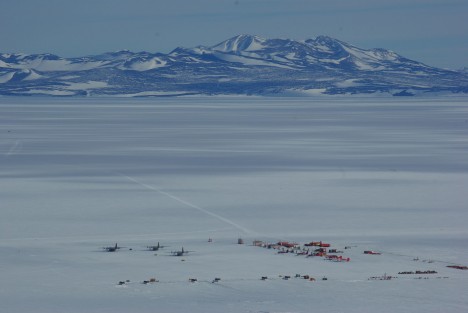
Nos premiers pas nous ont menés vers de particuliers engins, Delta et Terra bus, dédiés au transport en commun afin de relier la piste d’atterrissage à la Station de Mc Murdo.
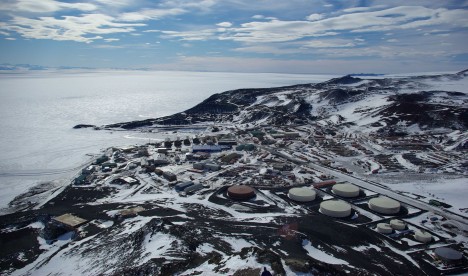
Les engins de transport à McMurdo sont soit équipés de chenilles, ou possèdent des roues d’une largeur exceptionnelle et d’une hauteur aussi grande que Clem!
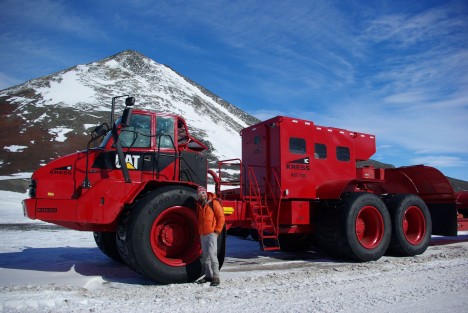
Mardi 22 et Mercredi 23, Jessica, Randy et Ludo ont suivi une formation de sécurité pour les déploiements en extérieur. Cette formation, bien mieux connue sous le nom de “Campeurs Joyeux!”, inclue une nuitée ensoleillée dehors, à proximité du Mont Erebus sur la plate-forme glaciaire de Ross. Pour varier les plaisirs, Jessica a passé la nuit dans une tente standard en forme de dôme, Randy dans une tente Scott en forme pyramidale afin de résister aux vents antarctiques. Sur recommandation de Clément, Ludo a quant à lui creusé une tranchée pour y passer une excellente nuit ensoleillée avec un panorama fantastique.

Durant ce temps, l’autre partie du groupe a commencé la chasse aux caisses d’équipement envoyées depuis le Kansas en septembre dernier. Malheureusement, nos radars n’ont pas été trouvés… Apres quelques heures de recherches ils ont été localisés sur un bateau à Christchurch.
Durant la journée du Jeudi 24, nous avons tous apporté notre grain de sel aux préparations. Il s’agissait de préparer les caisses de nourriture pour les prochaines semaines, soit 350 kg d’aliments.
La dernière journée de cette première semaine était dédié à finir les préparations de toutes les caisses en partance pour Byrd. Malheureusement les radars n’étaient toujours pas arrivés à McMurdo due aux conditions météorologiques empêchant les C-17 de voler. Plus précisément, les avions auraient pu atterrirent sans difficultés mais durant la phase de descente ils avaient à traverser une couche humide qui auraient généré de la glace sur la carlingue de l’avion une fois posé. L’aileron de queue étant très haut sur ces avions et l’usage des produits dégivrant limité, aucun avion en provenance de Christchurch s’est posé depuis notre arrivé.
Dans l’espoir de recevoir très prochainement les radars, nous allons poursuivre notre découverte de Mc Murdo et de la base néo-zélandaise Scott durant le week-end de Thanksgiving.

By Lora Koenig
It’s Thursday, December 1, and I am, yet again, sitting in our office, waiting. As the saying goes, “hurry up and wait”: This rings true in Antarctica. Last week, we were waiting for our radars to arrive on a plane from Christchurch. Usually there are about three flights a week from Christchurch to McMurdo, but an entire week of flights was canceled due to bad weather here. And finally, a plane arrived on Monday, November 28, bringing fresh fruit, new people and, most importantly, our radars.
Ludo and Clem quickly set up the two radars, ran a few tests to make sure they were working and repacked them for shipping to Byrd Camp. Normally we would take a few days to do this but, since we were delayed, we all worked hard and completed the tasks in a few hours. We repacked the equipment very carefully to prevent damage, and put it into the cargo system. (See Michelle’s blog post to learn more about the cargo system). Our intracontinential cargo needed to be in the system 48 hours in advance, and we were hoping to fly to Byrd on December 1 (that is, today).
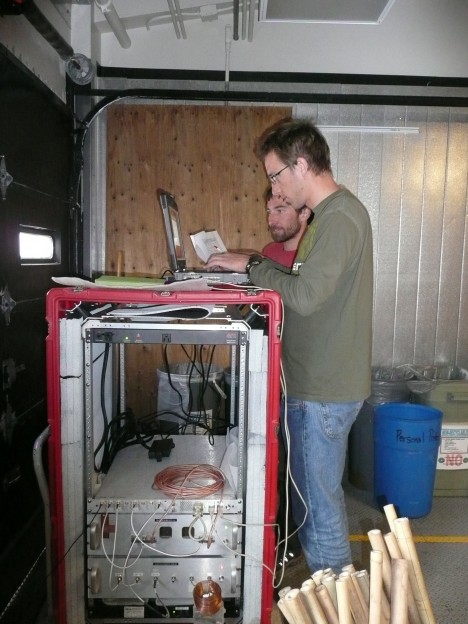
Just as a reminder here is the location we are trying to get to.
So our estimated departure date has come and gone, and here we are still in McMurdo. This is not a big surprise; delays are common in such a harsh environment. We are now scheduled to go to Byrd on Monday December 5. All of our work in McMurdo is done, so we will use the delay to rest a bit before the hard work of the traverse begins.
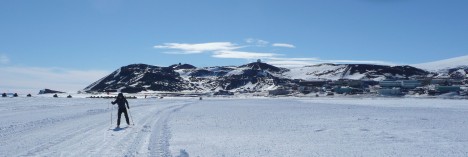
Why are we delayed? First, as I mentioned, McMurdo had a week of bad weather and no planes could land or take off. And once the weather in McMurdo cleared, it was Byrd’s turn to have bad weather, so planes could not land there. On top of that, there is a lot of science going on at Byrd this season, including another traverse lead by a NASA colleague, Bob Bindschadler, headed to Pine Island Glacier. (Check out this video on the Pine Island project, or visit their website.) Because there are so many teams flying to Byrd, we have to wait for five flights to get in before we are assigned a plane load for our science gear, fuel, snowmobiles and ice core boxes. Our team has a full LC-130 plane load of gear that needs to make it to Byrd.
Yesterday, they were finally able to get some flights into Byrd. Our flight number is T012; flight T010 will take off for Byrd this evening, then T011 has to fly and then it’s us. We are watching the monitors in McMurdo that show the flight status, just like at the airports, hoping that flights get in. We cheer when a flight returns and groan when a flight is canceled due to weather.
There is one more issue that is causing delays. This week they are moving the runways at McMurdo. In the early season, when it is still cold, the planes land very close to McMurdo on the sea ice at a place called Icey Runway. As temperatures warm, sea ice thins and the runway is moved farther inland to Williams Field, where the ice is thicker. This weekend is when they move airports, so there are no flights scheduled for Friday or Saturday (normally, there would be flights Monday through Saturday). So we will have another weekend in McMurdo, and when it’s time to fly to Byrd we’ll do it from William’s Field, about a 45-minute drive from McMurdo.
While we were waiting, I finally took some pictures of Percy the Penguin. Percy was given to me by a friend; it came from a geocache site in Seattle, WA and has now made it to Antarctica. Percy is actually the only penguin we have seen here. So far, the only wildlife we have encountered are skuas, large seagull-like birds, and Weddell seals that lounge on the sea ice just outside of McMurdo and Scott base. Through there are no seals in the picture of Michelle skiing, she is on an ice shelf below which the seals could be swimming. When the seals find a hole in the ice they come up onto the sea ice or ice shelf and lounge in the sun.

By Clement Miege
Hello everybody! This is Clement, for my first blog post! Sunday, November 27 was our day off, so we went exploring the surroundings of McMurdo Station. At around noon, Michelle and Lora decided to go cross-country skiing on sea ice while Jessica and Randy went to Scott Base for some shopping at the Kiwi store, which is stocked with lots of Antarctic T-shirts and other souvenirs.
On our side, Ludo and I took advantage of the wonderful weather and hiked the Castle Rock loop. I hiked this trail last year and it is by far my favorite walk near the station. We started at the fire house at around 11:30 AM. Because the trail is pretty long (9.8 miles), we were required to take a radio with us and give our estimated return time and the contact info for our point of contact in town to the responder on duty at the firehouse.
The walk toward the summit of Castle Rock is very pretty, with amazing views everywhere: behind us, we had Mount Discovery and the Royal Society Mountain Range. In front of us, we had incredible scenery with Castle Rock in front of Mount Erebus and Mount Terror. While approaching Castle Rock, we were able to enjoy a nice scramble leading us to the summit, with fixed ropes set for safety on the ascent. After a quick break at the summit, where it was really windy, we decided to head back down.
Here is our hike in pictures so you can enjoy it as well.
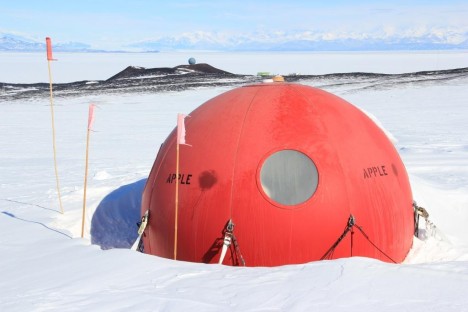
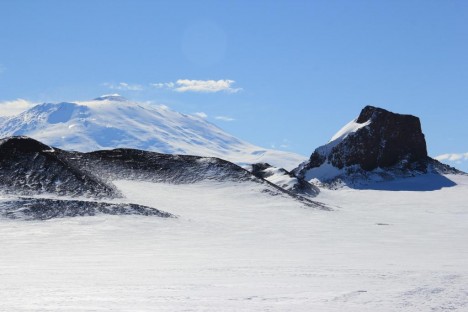

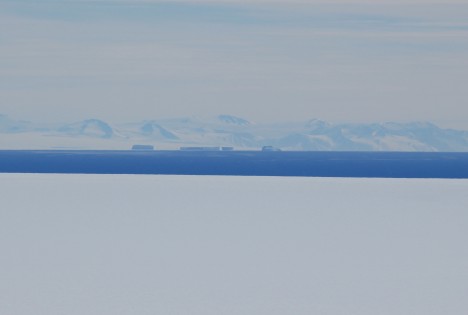

It took us about 4 hours to walk/slide through the whole loop. In fact, we cheated a little bit, taking advantage of the last shuttle to go back to McMurdo station from Scott Base, which knocked off about 2 miles. It was a wonderful trip; it was good to be outside while the weather was nice!
But that wasn’t the end of our day! After dinner, Jessica, Randy, Ludo and I went with a small group to Pegasus runway, an airfield near Mc Murdo station, to visit the remnants of a plane that crashed in 1970 and got stuck in the ice. It took us an hour to get there, travelling in a Delta. After spending a little time checking out the plane, we got back to the station at around 8:30 PM, ready to go to bed after a long day of adventures outside.
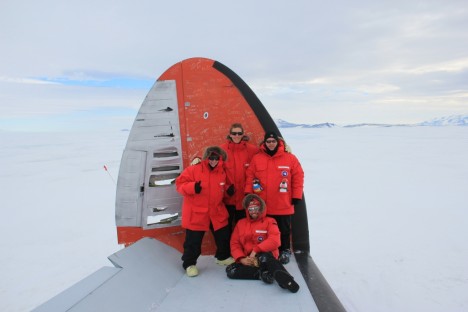

Here are some bits of info that I was able to collect on this crash, where fortunately nobody died. The plane, a C-121J named Pegasus, took off from Christchurch, New Zealand in October 1970. The flight to McMurdo went well until a storm started developing near the runway. Unfortunately, the flight had already passed the point of safe return, which meant that it did not have enough fuel to make it back to Christchurch. The only choice remaining was trying to land with no visibility. After a long time circling above the runway to get a little bit of visual information, the pilots attempted to land and the plane slid into a heavy snowdrift deposed by the storm, spun and broke its entire right wing and finally stopped. Luckily, nobody died in this accident.
If you would like to get more information on this story, follow this link.
Now this site is becoming a touristic attraction but it still shows a part of the Antarctic history. After this dramatic event, more precautions have been taken to allow planes to boomerang back to Christchurch if they run into bad weather.